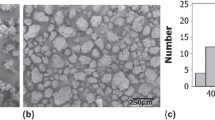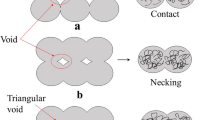Abstract
Fused deposition modeling is a rapidly evolving manufacturing technique that can produce products with complex geometries in minimum waste. However, the limited material selections and poor quality in the products from this technique restrict its applications. Many researchers have found some parameters affecting single-material specimen mechanical properties, layer thickness, infill density, and printing speed. However, few manufacturing parameter studies have examined dual-material products. This study used acrylonitrile butadiene styrene and polyethylene-terephthalate-glycol to fabricate dual-material samples because of their characteristics. All samples were first fabricated half-thickness acrylonitrile butadiene styrene base with polyethylene-terephthalate-glycol part fabricated onto, since the functionalities from both can be obtained from this configuration. Sixteen batches were produced in relation to printing speed, layer thickness, and infill density using the orthogonal method, followed by parameter optimization and a verification test. The batch with the parameters of 30 mm/s printing speed, 0.1 mm layer thickness, and 75% infill density produced the best combination for samples (the highest tensile strength (44.73 MPa) and Young’s modulus (758.12 MPa)). This run finished fabrication in 113 min, faster than run 9 in the orthogonal method, which had the highest tensile performance of the 16 runs. The morphologies agreed the results and found a lower layer thickness increased layers in fabrication with less pores and voids. This research on FDM-produced multi-material specimens’ mechanical properties increases the likelihood that this technique will be used in future manufacturing.






Similar content being viewed by others
References
Tymrak BM, Kreiger M, Pearce JM (2014) Mechanical properties of components fabricated with open-source 3-D printers under realistic environmental conditions. Mater Des 58:242–246. https://doi.org/10.1016/j.matdes.2014.02.038
Sugavaneswaran M, Arumaikkannu G (2015) Analytical and experimental investigation on elastic modulus of reinforced additive manufactured structure. Mater Des 66:29–36. https://doi.org/10.1016/j.matdes.2014.10.029
Domingo-Espin M, Puigoriol-Forcada JM, Garcia-Granada AA, Llumà J, Borros S, Reyes G (2015) Mechanical property characterization and simulation of fused deposition modeling Polycarbonate parts. Mater Des 83:670–677. https://doi.org/10.1016/j.matdes.2015.06.074
Casavola C, Cazzato A, Moramarco V, Pappalettere C (2016) Orthotropic mechanical properties of fused deposition modelling parts described by classical laminate theory. Mater Des 90:453–458. https://doi.org/10.1016/j.matdes.2015.11.009
Gong K, Liu H, Huang C, Cao Z, Fuenmayor E, Major I (2022) Hybrid manufacturing of acrylonitrile butadiene styrene (ABS) via the combination of material extrusion additive manufacturing and injection molding. Polymers 14(23):5093. https://doi.org/10.3390/polym14235093
Solomon IJ, Sevvel P, Gunasekaran J (2020) A review on the various processing parameters in FDM. Mater Today: Proc:509–514. https://doi.org/10.1016/j.matpr.2020.05.484
Xu H, Ebrahimi F, Gong K, Cao Z, Fuenmayor E, Major I (2023) Hybrid manufacturing of oral solid dosage forms via overprinting of injection-molded tablet substrates. Pharmaceutics 15(2):507. https://doi.org/10.3390/pharmaceutics15020507
Dawoud M, Taha I, Ebeid SJ (2016) Mechanical behaviour of ABS: an experimental study using FDM and injection moulding techniques. J Manuf Process 21:39–45. https://doi.org/10.1016/j.jmapro.2015.11.002
Chohan JS, Singh R (2016) Enhancing dimensional accuracy of FDM based biomedical implant replicas by statistically controlled vapor smoothing process. Progress in Additive Manufacturing 1(1-2):105–113. https://doi.org/10.1007/s40964-016-0009-4
Nabavi-Kivi A, Ayatollahi MR, Rezaeian P, Razavi SMJ (2021) Investigating the effect of printing speed and mode mixity on the fracture behavior of FDM-ABS specimens. Theoretical and Applied Fracture Mechanics 118:103223. https://doi.org/10.1016/j.tafmec.2021.103223
Aquino RP, Barile S, Grasso A, Saviano M (2018) Envisioning smart and sustainable healthcare: 3D printing technologies for personalized medication. Futures 103:35–50. https://doi.org/10.1016/j.futures.2018.03.002
Fuenmayor E et al (2019) Mass-customization of oral tablets via the combination of 3D printing and injection molding. Int J Pharm 569:118611. https://doi.org/10.1016/j.ijpharm.2019.118611
Araújo MRP, Sa-Barreto LL, Gratieri T, Gelfuso GM, Cunha-Filho M (2019) The digital pharmacies era: how 3D printing technology using fused deposition modeling can become a reality. Pharmaceutics 11(3). https://doi.org/10.3390/pharmaceutics11030128
Rigotti D, Dorigato A, Pegoretti A (2018) 3D printable thermoplastic polyurethane blends with thermal energy storage/release capabilities. Mater Today Commun 15:228–235. https://doi.org/10.1016/j.mtcomm.2018.03.009
Liu Y, Liang X, Saeed A, Lan W, Qin W (2019) Properties of 3D printed dough and optimization of printing parameters. Innov Food Sci Emerg Technol 54:9–18. https://doi.org/10.1016/j.ifset.2019.03.008
Barile G, Esposito P, Stornelli V, Ferri G (2023) Development and analysis of a multimaterial FDM 3D printed capacitive accelerometer. IEEE Access:1. https://doi.org/10.1109/ACCESS.2023.3246731
Quero RF, de Castro Costa BM, da Silva JAF, de Jesus DP (2022) Using multi-material fused deposition modeling (FDM) for one-step 3D printing of microfluidic capillary electrophoresis with integrated electrodes for capacitively coupled contactless conductivity detection. Sens Actuators B 365:131959. https://doi.org/10.1016/j.snb.2022.131959
Han D, Lee H (2020) Recent advances in multi-material additive manufacturing: methods and applications. Curr Opin Chem Eng 28:158–166. https://doi.org/10.1016/j.coche.2020.03.004
Gebisa AW, Lemu HG (2019) Influence of 3D printing FDM process parameters on tensile property of ultem 9085. Procedia Manuf 30:331–338. https://doi.org/10.1016/j.promfg.2019.02.047
Singh R, Bedi P, Fraternali F, Ahuja IPS (2016) Effect of single particle size, double particle size and triple particle size Al 2 O 3 in Nylon-6 matrix on mechanical properties of feed stock filament for FDM. Compos Part B Eng 106:20–27. https://doi.org/10.1016/j.compositesb.2016.08.039
Pham DT, Gault RS (1998) A comparison of rapid prototyping technologies
Gong K et al (2022) Mass customization of polylactic acid (PLA) parts via a hybrid manufacturing process. Polymers 14(24):5413. https://doi.org/10.3390/polym14245413
Gong K, Xu H, Liu H, Cao Z, Fuenmayor E, Major I (2023) Hybrid manufacturing of mixed-material bilayer parts via injection molding and material extrusion three-dimensional printing. J Appl Polym Sci. https://doi.org/10.1002/app.53972
Rodríguez-Panes A, Claver J, Camacho AM (2018) The influence of manufacturing parameters on the mechanical behaviour of PLA and ABS pieces manufactured by FDM: a comparative analysis. Materials 11(8). https://doi.org/10.3390/ma11081333
Durgun I, Ertan R (2014) Experimental investigation of FDM process for improvement of mechanical properties and production cost. Rapid Prototyp J 20(3):228–235. https://doi.org/10.1108/RPJ-10-2012-0091
Popescu D, Zapciu A, Amza C, Baciu F, Marinescu R (2018) FDM process parameters influence over the mechanical properties of polymer specimens: a review. Polym Test 69:157–166. https://doi.org/10.1016/j.polymertesting.2018.05.020
Deng X, Zeng Z, Peng B, Yan S, Ke W (2018) Mechanical properties optimization of poly-ether-ether-ketone via fused deposition modeling. Materials 11(2). https://doi.org/10.3390/ma11020216
Sikder P, Challa BT, Gummadi SK (2022) A comprehensive analysis on the processing-structure-property relationships of FDM-based 3-D printed polyetheretherketone (PEEK) structures. Materialia 22:101427. https://doi.org/10.1016/j.mtla.2022.101427
Chacón JM, Caminero MA, García-Plaza E, Núñez PJ (2017) Additive manufacturing of PLA structures using fused deposition modelling: effect of process parameters on mechanical properties and their optimal selection. Mater Des 124:143–157. https://doi.org/10.1016/j.matdes.2017.03.065
Lokesh N, Praveena BA, Sudheer Reddy J, Vasu VK, Vijaykumar S (2021) Evaluation on effect of printing process parameter through Taguchi approach on mechanical properties of 3D printed PLA specimens using FDM at constant printing temperature. Mater Today Proc. https://doi.org/10.1016/j.matpr.2021.11.054
Torrado AR, Roberson DA (2016) Failure analysis and anisotropy evaluation of 3D-printed tensile test specimens of different geometries and print raster patterns. JFAP 16(1):154–164. https://doi.org/10.1007/s11668-016-0067-4
Durgashyam K, Indra Reddy M, Balakrishna A, Satyanarayana K (2019) Experimental investigation on mechanical properties of PETG material processed by fused deposition modeling method. Mater Today Proc 18:2052–2059. https://doi.org/10.1016/j.matpr.2019.06.082
Wang H, Yang W, Jiao Z, Chi B, Yan H (2018) Effects of filling ratio in FDM technology on the mechanical properties of plastic products. Plastics 47(01):92–94,112
Rodríguez JF, Thomas JP, Renaud JE (2001) Mechanical behavior of acrylonitrile butadiene styrene (ABS) fused deposition materials. Experimental investigation. Rapid Prototyp J 7(3):148–158. https://doi.org/10.1108/13552540110395547
Ziemian C, Sharma M, Ziemian S (2012) Anisotropic mechanical properties of ABS parts fabricated by fused deposition modelling. In: Mech Eng p 159
Masood S, Mau K, Song W (2010) Tensile properties of processed FDM polycarbonate material. Mater Sci Forum 654–656:2556–2559. https://doi.org/10.4028/www.scientific.net/MSF.654-656.2556
Wang CC, Lin TW, Hu SS (2007) Optimizing the rapid prototyping process by integrating the Taguchi method with the Gray relational analysis. Rapid Prototyp J 13(5):304–315. https://doi.org/10.1108/13552540710824814
Anitha R, Arunachalam S, Radhakrishnan P (2001) Critical parameters influencing the quality of prototypes in fused deposition modelling. J Mater Process Technol 118(1-3):385–388. https://doi.org/10.1016/S0924-0136(01)00980-3
Yin J, Lu C, Fu J, Huang Y, Zheng Y (2018) Interfacial bonding during multi-material fused deposition modeling (FDM) process due to inter-molecular diffusion. Mater Des 150:104–112. https://doi.org/10.1016/j.matdes.2018.04.029
Szust A, Adamski G (2022) Using thermal annealing and salt remelting to increase tensile properties of 3D FDM prints. Eng Fail Anal 132:105932. https://doi.org/10.1016/j.engfailanal.2021.105932
Fountas NA, Papantoniou I, Kechagias JD, Manolakos DE, Vaxevanidis NM (2022) Modeling and optimization of flexural properties of FDM-processed PET-G specimens using RSM and GWO algorithm. Eng Fail Anal 138. https://doi.org/10.1016/j.engfailanal.2022.106340
Fuenmayor E et al (2018) Material considerations for fused-filament fabrication of solid dosage forms. Pharmaceutics 10(2):1–27. https://doi.org/10.3390/pharmaceutics10020044
Rodríguez JF, Thomas JP, Renaud JE (2003) Design of fused-deposition ABS components for stiffness and strength. Journal of Mechanical Design, Transactions of the ASME 125(3):545–551. https://doi.org/10.1115/1.1582499
Lay M, Thajudin NLN, Hamid ZAA, Rusli A, Abdullah MK, Shuib RK (2019) Comparison of physical and mechanical properties of PLA, ABS and nylon 6 fabricated using fused deposition modeling and injection molding. Compos Part B Eng 176:107341. https://doi.org/10.1016/j.compositesb.2019.107341
Christiyan KGJ, Chandrasekhar U, Venkateswarlu K (2016) A study on the influence of process parameters on the mechanical properties of 3D printed ABS composite. IOP Conf Ser Mater Sci Eng 114(1). https://doi.org/10.1088/1757-899X/114/1/012109
Cao Z, Daly M, Geever LM, Major I, Higginbotham CL, Devine DM (2016) Synthesis and characterization of high density polyethylene/peat ash composites. Compos Part B Eng 94:312–321. https://doi.org/10.1016/j.compositesb.2016.03.009
Torrado AR, Shemelya CM, English JD, Lin Y, Wicker RB, Roberson DA (2015) Characterizing the effect of additives to ABS on the mechanical property anisotropy of specimens fabricated by material extrusion 3D printing. Addit Manuf 6:16–29. https://doi.org/10.1016/j.addma.2015.02.001
Ebel E, Sinnemann T (2014) Fabrication of FDM 3D objects with ABS and PLA and determination of their mechanical properties. RTejournal https://www.rtejournal.de/ausgabe11/3872
Baich L, Manogharan G, Marie H (2015) Study of infill print design on production cost-time of 3D printed ABS parts. Int J Rapid Manuf 5(3-4):308. https://doi.org/10.1504/ijrapidm.2015.074809
Author information
Authors and Affiliations
Contributions
All authors contributed to the study conception and design. Material preparation was performed by Zhixin Chen, Ke Gong, Cheng Huang, Sihan Hu, Evert Fuenmayor, and Ian Major; data collection was performed by Zhixin Chen, Ke Gong, Cheng Huang, and Zhi Cao; analysis was performed by Zhixin Chen, Ke Gong, Cheng Huang, and Han Xu. The first draft of the manuscript was written by Zhixin Chen, Ke Gong, Cheng Huang, and Ian Major. All authors commented on previous versions of the manuscript. All authors read and approved the final manuscript.
Corresponding author
Ethics declarations
Competing interests
The authors declare no competing interests.
Additional information
Publisher’s note
Springer Nature remains neutral with regard to jurisdictional claims in published maps and institutional affiliations.
Rights and permissions
Springer Nature or its licensor (e.g. a society or other partner) holds exclusive rights to this article under a publishing agreement with the author(s) or other rightsholder(s); author self-archiving of the accepted manuscript version of this article is solely governed by the terms of such publishing agreement and applicable law.
About this article
Cite this article
Chen, Z., Gong, K., Huang, C. et al. Parameter optimization for PETG/ABS bilayer tensile specimens in material extrusion 3D printing through orthogonal method. Int J Adv Manuf Technol 127, 447–458 (2023). https://doi.org/10.1007/s00170-023-11515-w
Received:
Accepted:
Published:
Issue Date:
DOI: https://doi.org/10.1007/s00170-023-11515-w




